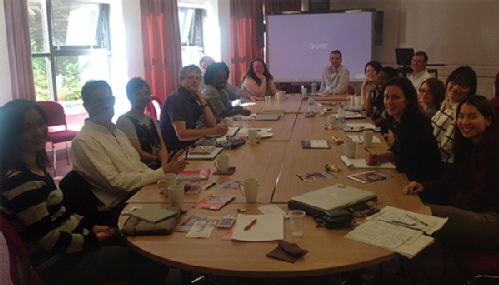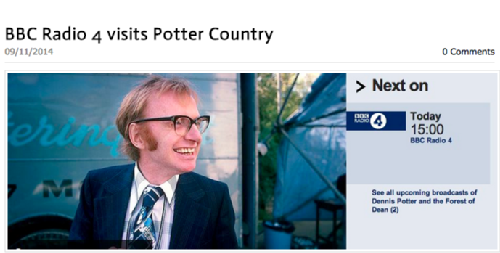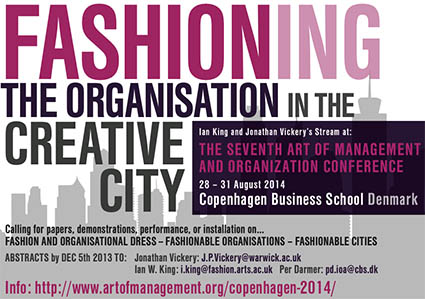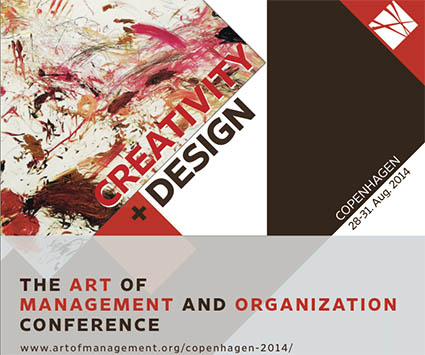All entries for September 2014
September 27, 2014
Centre PhD Day 2014
Friday 26th September 2014 was our PhD Day, which lasted from 10am to 4pm and found most of the Centre's PhD students and staff in deep discussion about a range of significant issues. The day was organised and convened by Dr David Wright, and during the course of the day we were joined by a Senior Advisor from Warwick Career and Skills Service and also Zara Hooley, the administrator of the new Faculty of Arts Centre for Arts Doctoral Research Excellence. The first half of the day featured an in-depth discussion on 'methods', with Centre staff each accounting for the role of methods in their research, and their views on methodology in general. This was regularly puctuated by questions, reflections and issues from the students, many of whom whose research projects are in full flow. After an agreeable lunch, the second half of the day featured a protracted discussion of the challenges of starting an academic career -- from attending conferences to research blogging, from networking to publications. Our PhD students are working on a wide range of topics -- from culture and religion in North Korea, to digital media in Africa, the creative city movement and its impact in East Asia, the Caribbean creative industries, arts practice in Brazil, Cultural entrepreneurship in the UK, the art world in Latvia, and many more !

September 17, 2014
All Roads Lead to Coventry
All Roads Lead to Coventry was a joint venture organised by Warwick Creative Exchange, Coventry Artspace and Warwick Arts Centre – the aim was to invite universities, arts organisations and council officers to share ideas about the longer term future for the city and the role that arts and culture could play in reimagining that future. Rather than spending day in meetings, we decided to invite participants to spend a morning walking and talking through Coventry, discovering and rediscovering some of the ‘hidden gems’ which are tucked away across the city (museums, theatres, statues and historic buildings) as well as encountering the everyday experience of a richly varied (but still compact) contemporary city. And so, on a sunny September morning in Coventry, our journey began.

The walks were designed by Simon Bedford, an associate producer at Warwick Arts Centre who greeted us at our starting point – appropriately enough, a car park midway between the city centre and the university. Here we were divided into ten small groups, each comprising cultural producers, academics from Coventry and Warwick universities and some of the senior officers at Coventry City Council. There was a buzz of anticipation – we knew our final destination (the EGO performance space close to the Transport Museum), and we knew that there would be some stops and talking points along the way, but the rest was up to us. Each group was given a map, a few notes on things to look out for and some questions to start the conversation, some chocolate – and away we went.
Our walks started from ten locations across the city, converging in the city centre. My own journey took in the village atmosphere of Earlsdon, the statue of Frank Whittle (inventor of the jet engine and a reminder of the city’s heritage as a centre of engineering, innovation and manufacturing) and the Albany Theatre, a beautiful 600-seat theatre run entirely by volunteers with big plans to relaunch itself as a centre for community arts. Like many of the places we visited, the Albany is hidden in plain sight, tucked away in an impressive former college which it shares, rather bizarrely, with a Premier Inn (see picture below right).


Other groups walked along the canal, visited Coventry’s music museum (home of The Specials and a back catalogue of ska and reggae), looked at the new Fargo development or took in the Hillfields neighbourhood.
Coventry is often identified with its history of motor manufacturing and today it is still dominated by the ringroad – an impressive feat of engineering and a vital artery for people who live and work in the area – but also a symbolic barrier which seems to cut off the city centre from the diverse neighbourhoods beyond. So it was refreshing to be able to walk the city, meandering through its many histories, guided by people who knew its hidden corners and byways.
All walks led to EGO performance space – here we were served a wholesome lunch, shared stories from the day and tried to connect our experiences of the city into a bigger picture.
It became clear in the conversations during and after the walks that people who know Coventry well enjoy sharing its secret histories and hidden pockets of culture and community. But for outsiders, like many of the academics and students at the city’s two universities (including myself), the city is hard to ‘read’ (and hard to navigate!). One of the challenges we confronted was how to connect the city’s diverse histories and communities into a coherent narrative – how can we sell this complicated, fragmented, reticent city in a world dominated by brash city ‘brands’ and honeypot tourist destinations? Coventry is a city which wears its history lightly – ancient cottages house kebab shops, the old city walls skirt brutal modernist buildings. How can we connect the city’s many pasts and presents into a new future? What part can the arts and culture play in drawing the city together and opening it out to visitors? What are the barriers in the way of what we want the city to become?

These questions will be part of a series of ongoing conversations between artists, academics and council officers and members over the coming months. If you would like to get involved, please visit the Warwick Creative Exchange website – we will be posting some pictures and blog posts from the day, and posting details of future activities and projects designed to reimagine the city and its culture. You can also continue the journey we started with All Roads Lead to Coventry by visiting Coventry Artspace’s City Arcadia Project, a series of art installations which reimagine a city in transition, beginning with Kathryn Hawkins’ sculptural installation, (river). Or use your smartphone to follow the Trails of the Unexpected walk, designed by Janet Vaughan of Talking Birds and built by digital artist and developer Ashley James Brown. Or just let us know what you think of the city in the comments section below.
September 16, 2014
The ICCPR 2014
This last week, cultural policy colleagues from around the world joined us in Hildesheim, Germany, for the International Conference on Cultural Policy Research: the ‘ICCPR2014’. Six of us Centre colleagues were there. I was speaking three times and chairing twice – not an itinerary I recommend. However, it is a great opportunity for making research contacts and seeing what is happening around Europe.

I thought the conference was successful, not just because we found ourselves in a charming place having cycled from the hotel along a beautiful river pathway to the out-of-town campus (see picture above). I thought it was successful because the scope of cultural research was expanded in unexpected ways…. specifically with a critical mass of colleagues from the Middle East, Africa and Asia. The presence of these colleagues was a result of the commitment of Hildesheim Institut fur Kulturpolitik to advancing cultural relations and intercultural dialogue in these parts of the world – where cultural rights, diversity, and sustainable development are not just policy cliches but real areas of ethical conflict and political contestation. For me (at least in the sessions I attended) Hildesheim colleagues threw up a challenge – how do we to advance the cause of justice and solidarity through the world through research? Are we just all playing the Western career game of personal advancement, or are we sharing our academic resources with the parts of the world under pressure or conflict?
Of course – this raises some difficult issues about the limitations of research, as much as the limitations of our institutional contexts. In my Thematic Panel (and it also came up in two other sessions I attended) the question of agency emerged. What is a cultural policy researcher – what mechanisms of legitimacy or representation do we use, particularly ‘in the field’? And, who are the real agents of cultural change in a given place – and do they include cultural policy researchers? The Hildesheim ICCPR seems to be saying that the cultural policy researcher should be a change agent through using the opportunities of the research process as the means of advancing cultural relations and intercultural dialogue (through collaborations, symposia, research trips, exchanges and so on). The processes of research thereby become part of the dynamics of change; or at least, this is the idea, and advanced somewhat by Hildesheim’s work with the Arab Cultural Policy Group and various projects in Africa.
In the conference itself, we had the usual diversity and wide range of topics, from colleagues from around 60 countries of the world. Altogether I listened at various times to research that engaged with important political contexts of UN and EU, national governments, public administration and city councils, NGOs, consultancies, and a range of other civil society organizations. There are few academic fields able to broach this breadth of application. Generally, there seemed to be an increasing attention in cultural policy to ‘place-based’, particularly urban, research. The theme of the conference was ‘cultural policy’ and so one would expect less papers on creative industries issues, and there were indeed few. Our Arab and African friends emphasises the problems of cultural policy in times of serious conflict or the fragmentation of the state. There were also some attention paid to religion – which was good (and something pioneered by Bennett and Ahearne just a few years ago).
It was not that long ago that people could be heard saying that cultural policy as a category of knowledge and public management is becoming redundant – supplanted by a diversity of interests in creative industries, entrepreneurship and enterprise, new civil society and third sector developments, and so on and on. And of course cultural policy tends to be nation-state-based and Euro-centric in its values and ideals. Speaking as an unashamed Europhile, I found this conference's re-assertion of cultural policy very necessary – and a return to the old questions on the nature of the state, civil society and basic democratic norms, necessary and timely. As our host, Professor Wollfgang Schneider emphasized on several occasions -- cultural policy is principally about the the political contexts of culture…and cultural policy research should not just be a force for the construction of knowledge, but a force for social change. But it wasn't all serious -- we also had a drink with some old friends, and past PhD students -- do you recognise them?

September 12, 2014
Why Past Television Matters
Hyperlocal memories of Dennis Potter: Why remembering past television matters
This year has marked the 20th anniversary since the death of an important British television screenwriter, Dennis Potter. As the Potter Matters blog states:
One of a handful of British writers, producers and directors who from the early 1960's onwards pushed at the boundaries of what television drama could do, he remains an influence on many of today's most significant television writers. Dennis Potter most certainly still matters!

 In our research for our most recent publication Remembering Dennis Potter through Fans, Extras and Archives (2014), we took the view that Potter matters to a different set of stakeholders in the cultural memory of television. Not directors, producers, the BBC, ITV, or the BFI, all of whom, to varying degrees have been interviewed, made commemorative programmes on TV and Radio, written editorials in The Guardian, produced exhibitions in London or screenings in selected regions, and have paid homage to Potter. Rather, the audience, the fan and the materiality of the evidence of paper and tape archives that accumulate in private and public collections, has been rather neglected. The desire to move Dennis Potter’s work into the schemata of high culture finds his television work publicly viewed in a cinematic theatre in London. This bears no resemblance whatsoever to the material living room conditions of the 1970s and 1980s where millions of people viewed Pennies from Heaven (1978) or The Singing Detective (1986) as not so much appointment television (there was much less competition for attention) but as a media event. What has Potter made for us now? How much will we be shocked? Viewed in a theatrical setting, Potter’s television is re-cast, not as popular culture (as it was), but as a form of quality television from the past, and as an origin of or precursor for more recent HBO experimentation in drama.
In our research for our most recent publication Remembering Dennis Potter through Fans, Extras and Archives (2014), we took the view that Potter matters to a different set of stakeholders in the cultural memory of television. Not directors, producers, the BBC, ITV, or the BFI, all of whom, to varying degrees have been interviewed, made commemorative programmes on TV and Radio, written editorials in The Guardian, produced exhibitions in London or screenings in selected regions, and have paid homage to Potter. Rather, the audience, the fan and the materiality of the evidence of paper and tape archives that accumulate in private and public collections, has been rather neglected. The desire to move Dennis Potter’s work into the schemata of high culture finds his television work publicly viewed in a cinematic theatre in London. This bears no resemblance whatsoever to the material living room conditions of the 1970s and 1980s where millions of people viewed Pennies from Heaven (1978) or The Singing Detective (1986) as not so much appointment television (there was much less competition for attention) but as a media event. What has Potter made for us now? How much will we be shocked? Viewed in a theatrical setting, Potter’s television is re-cast, not as popular culture (as it was), but as a form of quality television from the past, and as an origin of or precursor for more recent HBO experimentation in drama.
Memories and archives tell a different story and in their re-telling they keep those differences alive. As Carolyn Steedman eloquently puts it in Dust: The Archive and Cultural History, the archivist is in a ‘grubby trade’ for: ‘You know perfectly well that the infinite heaps of things they recorded, the notes and traces that these people left behind, constitute practically nothing at all’ (2001, 18). Only some of these traces and evidence end up in archives, such as BBC Written Archives at Caversham. Television has suffered this ‘nothing at all’ more than most. Early tape so expensive it had to be re-used alongside a perceived lack of cultural value has meant that only from the late 1970s was a secure policy and governance over retaining television broadcasts really practiced. Memories, on the other hand, of working in and with television provide alternative accounts, and the AHRC Spaces of Television: Production, Site and Style project at the University of Reading is a really excellent example of this kind of work.
 In our research, we have been interested in the communities that have supported, assisted in producing, watched and collected television, and a case study of the community of the Forest of Dean, Gloucestershire, described as Potterland, is an important example of what we would call hyperlocal memory. A very specific kind of cultural remembering through reference to the production of Potter’s works in the Forest that uses those works to shore up and ‘sure up’ certainties about regional identity and continua of cultural practices. We were not the only ones to spot this unique connection between Dennis Potter’s television production in the Forest and the continued legacy he has played out through the communicative memories of local residents. Not only is the Dennis Potter written archive now held at the Dean Heritage Centre, Soudley but one of our research team was production consultant for the recent BBC Radio 4 Open Country programme Dennis Potter and the Forest of Dean (Tx 11th Sept 2014). It is deeply heartening to hear the participants being interviewed having the opportunity to express their memories of Potter’s works being produced in the Forest. To hear them incorporate past television production not into a high culture aesthetic of cinematic value but into a hyperlocal community memory to be explored in the homes, gardens and trees of this ancient woodland with all its ancient Rights, demonstrates that television exists outside the flow (as many television scholars have argued).
In our research, we have been interested in the communities that have supported, assisted in producing, watched and collected television, and a case study of the community of the Forest of Dean, Gloucestershire, described as Potterland, is an important example of what we would call hyperlocal memory. A very specific kind of cultural remembering through reference to the production of Potter’s works in the Forest that uses those works to shore up and ‘sure up’ certainties about regional identity and continua of cultural practices. We were not the only ones to spot this unique connection between Dennis Potter’s television production in the Forest and the continued legacy he has played out through the communicative memories of local residents. Not only is the Dennis Potter written archive now held at the Dean Heritage Centre, Soudley but one of our research team was production consultant for the recent BBC Radio 4 Open Country programme Dennis Potter and the Forest of Dean (Tx 11th Sept 2014). It is deeply heartening to hear the participants being interviewed having the opportunity to express their memories of Potter’s works being produced in the Forest. To hear them incorporate past television production not into a high culture aesthetic of cinematic value but into a hyperlocal community memory to be explored in the homes, gardens and trees of this ancient woodland with all its ancient Rights, demonstrates that television exists outside the flow (as many television scholars have argued).
September 01, 2014
Art of Management and Organization
I have just come back from a conference at the Copenhagen Business School – called ‘Creativity and Design’ and run by the research organisation The Art of Management and Organization (of which I am the Chair). Apart from being involved in the conference planning, I was also running a stream (with Ian King, professor of aesthetics and management at the London College of Fashion) called ‘Fashioning the organisation in the creative city’. Awful title, I know, but it emerged from a stream we participated in at EGOS 2012 in Helsinki and organised by our friends at CBS.

The photo above is one of the art inteventions at the conference – the German art collective ENQuETE Art [Experimental Nonpartisan Questioning of Enduring Technologies in the Economy – it sounds better in German, believe me!]. These are four robotic creatures that are replete with sensors and able to interact with the conference audience, all the while performing a role in a drama (the loud speaker component bleats out rhetoric).
Our stream attempted to explore ‘fashion’ and the fashioning of the body (as style, expression, identity, medium of knowledge) in organizational life, with particular reference to the new cultural identity, policy and urbanisation of cities. The backround for this urban cultural dimension was discussions around the ‘new model worker’ (and ‘creative class’, etc.: Florida, 2002; 2005), new mobile ‘cultural creatives’ (Ray and Anderson, 2000), ‘bourgeois bohemians’ (Brooks, 2000), all situated within the new urbane ‘economy of the inner city’ (Hutton, 2002). Fashion is not just about clothes; it is the deep structure of the consumer economy, and an economy whose multiple foci are the world’s largest cities (now routinely referred to as fashion city, media city, creative city, ‘smart’ city, so on). The term ‘fashion’ is intriguing – so associated with the global circulation of ‘catwalk’ imagery and celebrity designers, and yet in reality is much more. It is a form of implicit cultural policy (a global cultural order for the world’s largest trades -- the garment trade, along with ‘accessories’). Yet the models, templates, patterns, visual and symbolic communication that determines the actual shape and aesthetics of fashion items (from clothes to bags) often emerge from the intimate creativity of the designers studio and his company. Fashion is both art and commerce, supply and demand, retailer and consumer; it is ‘a mystery’ (Esposito, 2011: Czarniawska, 2011). Last year Ian and me published a paper in the Scandinavian Journal of Management on this subject, pondering why fashion is still derided within mainstream cultural research.

Apart from organising the stream, we also contributed a paper – which attempted to be multi-media insofar as I screened an edited version of a film as I talked my way through it. The paper was called 'An urban phenomenology of fabric: on Wim Wenders' 'Notebooks on Cities and Clothes'. The film was Wenders 1989 documentary, which, I must admit, some find very tedious. To me (when I first saw it in 1989!), was a revelation. I have since wanted to revisit the film and say something about it – about how Wenders, who at the time had little interest in fashion, through the process of making the documentary uncovered something quite profound about its social and aesthetic meaning. In the paper we attempted to explore the relation between fashion and what we called organisational urbanisation (why fashion is associated with cities, and emerges from the experience of urban modernisation), and what the implications of this are for thinking about the study of organisations. Commissioned by the Centre Pompidou, Wenders explores fashion through an intimate encounter with Yohji Yamamoto, the Japanese fashion designer. The documentary flips between Tokyo and Paris, exploring questions on the changing experience of the city and human identity. We took ‘phenomenology’ as the subject of the paper’s method – I say subject as the paper doesn’t ‘do’ phenomenology, it just uses it as a framework to think deeper on the relation between the body, perception/experience and environment (in this case, the city). The ‘fabric’ aspect relates to Yamamoto’s method of design, which begins with his experience of touch and feeling the material, as well as his reflections on the material conditions of human identity. The paper will be published in October by CBS in the conference proceedings.

 Jonathan Vickery
Jonathan Vickery

 Please wait - comments are loading
Please wait - comments are loading

 Loading…
Loading…